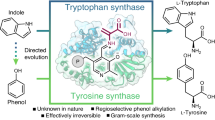Abstract
POLYRIBOADENYLATE polymerase1 is a ubiquitous enzyme whose biological role is not fully understood. Recently, the inhibition of poly A polymerase in Escherichia coli infected with T-even phages2 was tentatively related to the concomitant arrest of the synthesis of macromolecule in the bacterial host3. Its function might be further elucidated if a conditional lethal mutant could be found in which poly A polymerase is temperature sensitive. Screening for such a mutant among a set of ts mutants unable to perform protein synthesis at high temperature was undertaken by Dr G. Tocchini-Valentini using techniques already described4. 1 ml. of tryptone broth containing 5 × 108 cells of any one of the mutant derivatives of E. coli D14 (Hfr C met−RCrel) was sonicated and mixed with 1.5 ml. of 20 mM Tris (pH 9.5), 4.9 g/l. of magnesium acetate, 20 mg/l. deoxyribonuclease (ribonuclease free, Sigma), 10 mg/1. tRNA (from E. coli, General Biochemical), 55 mg of 14C-ATP (New England Nuclear) at a specific radioactivity of 0.5 mCi/mmole. This was done in duplicate: one preparation was then incubated for 20 min at 30° C, and the other at 42° C. Incubation was stopped by the addition of an equal volume of 10 per cent trichloroacetic acid (TCA) and the samples were filtered on ‘Millipore’ filters and counted in a gas flow low-background counter. To check that the TCA insoluble product from this crude extract was really poly A, a control was performed using a-32P-ATP, hydrolysing the precipitate with alkali and checking that all the radioactivity was recovered after paper electrophoresis (in acetate buffer, pH 3.5) in the AMP spot. In a set of 200 ts mutants unable to synthesize protein at high temperature, three exhibited temperature sensitive poly A polymerase activity. They were crossed and gave no wild type recombinants. Successive experiments were done using one of the three which we call C134 (see Table 1).
This is a preview of subscription content, access via your institution
Access options
Subscribe to this journal
Receive 51 print issues and online access
$199.00 per year
only $3.90 per issue
Buy this article
- Purchase on Springer Link
- Instant access to full article PDF
Prices may be subject to local taxes which are calculated during checkout
Similar content being viewed by others
References
August, J. T., Ortiz, P. J., and Hurwitz, J., J. Biol. Chem., 237, 3786 (1961).
Ortiz, P. J., August, J. T., Watanabe, M., Kaye, A. M., and Hurwitz, J., J. Biol. Chem., 240, 423 (1965).
Colvill, A. J. E., and Terzi, M., Biochim. Biophys. Acta, 155, 394 (1968).
Tocchini-Valentini, G. P., and Mattoccia, E., Proc. US Nat. Acad. Sci., 61, 146 (1968).
Terzi, M., and Levinthal, C., J. Mol. Biol., 26, 525 (1967).
Burgess, R. R., Travers, A. A., Dunn, J. J., and Bautz, E. K. F., Nature, 221, 43 (1969).
Author information
Authors and Affiliations
Rights and permissions
About this article
Cite this article
TERZI, M., CASCINO, A. & URBANI, C. Polyriboadenylate Polymerase and its Relationship with RNA Polymerase. Nature 226, 1052–1054 (1970). https://doi.org/10.1038/2261052a0
Received:
Issue Date:
DOI: https://doi.org/10.1038/2261052a0
This article is cited by
-
Isolation and Characterization of Poly A Polymerase from Cell Debris of E. coli
Nature New Biology (1972)
Comments
By submitting a comment you agree to abide by our Terms and Community Guidelines. If you find something abusive or that does not comply with our terms or guidelines please flag it as inappropriate.


